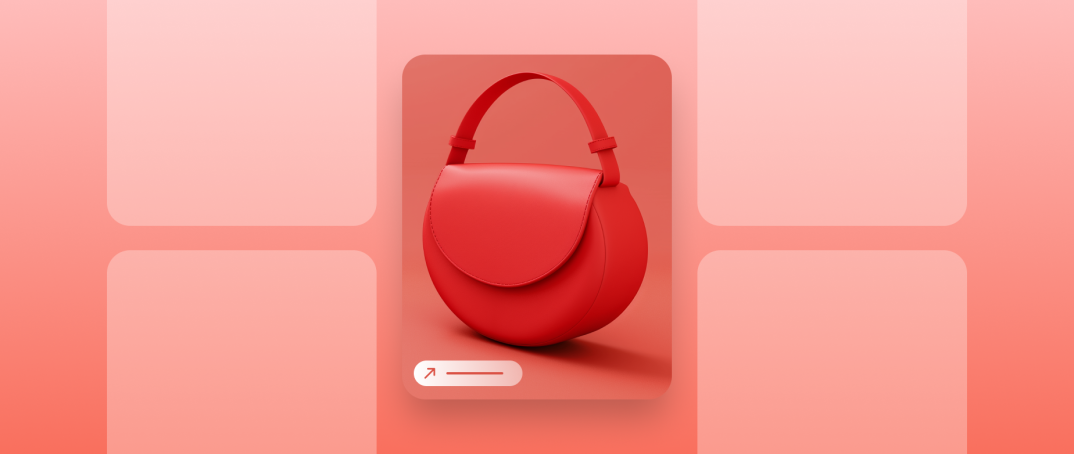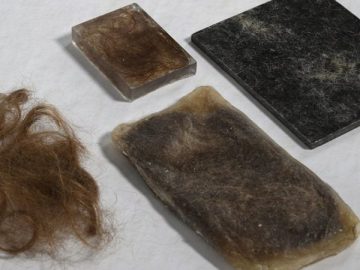Pinterest is a place to collect ideas and inspiration for a new project—or a big purchase. These user habits help Pinterest predict upcoming trends, providing valuable insights to businesses on the platform.
With more than 500 million monthly active users, Pinterest isn’t the largest social platform in the world. But, its unique audience and their motivations make it the perfect place for brands to get discovered: 80% of Pinners say they have purchased something they found on Pinterest.
Pinterest isn’t just a valuable marketing tool for brands looking to reach the platform’s young audience. It’s also a powerful sales channel. Ahead, learn how to sell on Pinterest, sync online sales with your account, and get the most from the social media platform’s shopping features.
Why sell products on Pinterest?
Pinterest is an ideal channel for selling products online for a few key reasons:
Pinterest is a product discovery channel
As 97% of top searches on Pinterest are unbranded, Pinterest users are looking to the platform for recommendations. Brands that surface their products with the right targeting can reach eager buyers. When users click on Pinterest’s search bar, popular and tailored search ideas help them discover products:
It has a distinct audience
If your target audience skews toward younger women, your brand should be on Pinterest. The majority of Pinterest users fall into the 25-to-34-year-old age group, but adoption is growing among Gen Z users, who now make up 42% of the user base. Pinterest is also distinct for its gender demographics: almost 70% of users identify as female.
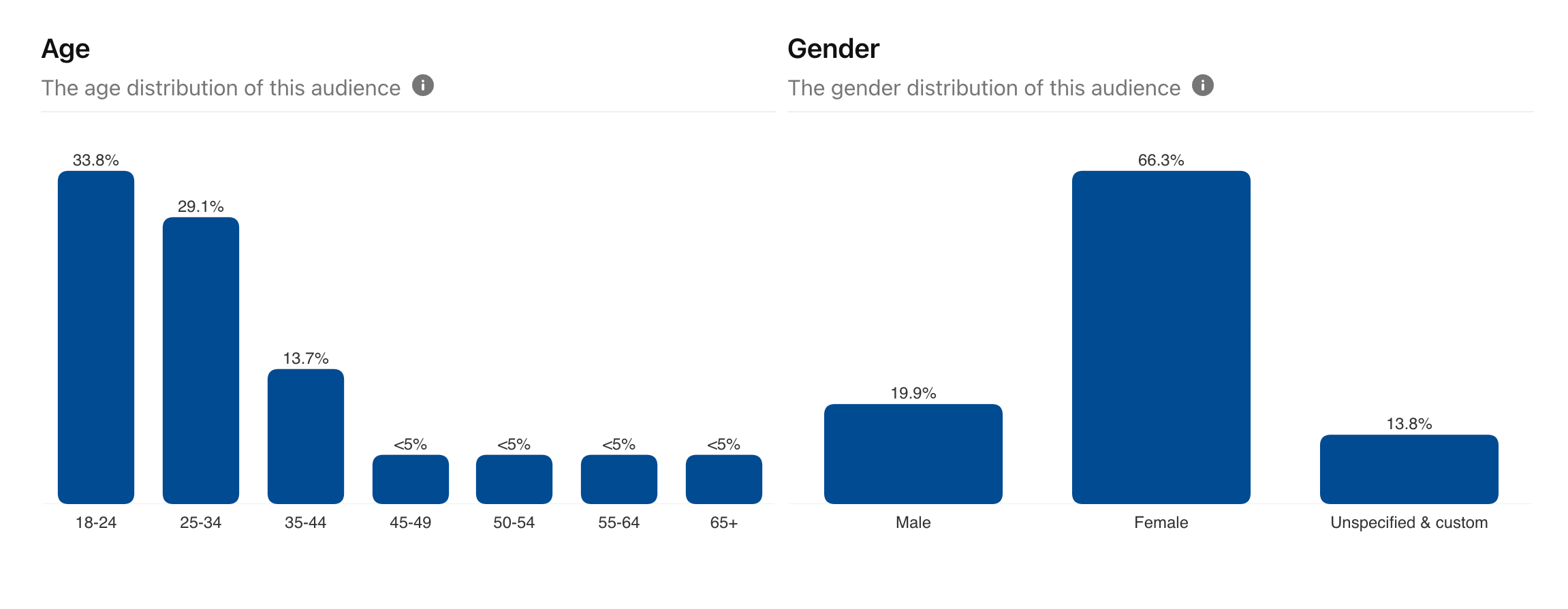
Pinterest offers paid ads
Adding Pinterest ads to your paid social media marketing strategy means getting even more targeted with your Pinterest marketing efforts. Brands that advertise on Pinterest earn double the return on ad spend compared to on other social media networks.
Access robust audience insights
Pinterest provides specific insights about your audience with Pinterest Analytics, which helps you see what content performs well, who’s interested in your brand, and what other interests those people have. Dial in on your account’s audience to see a breakdown of Pinterest demographics like location, gender, and age.
Take advantage of unique shopping features
Brands with a business Pinterest account can upload their products using Catalog. Merchants who do so earn five times more impressions than brands that don’t add products. Another feature is Pinterest Try On, which uses augmented reality (AR) to allow shoppers to “try on” products virtually.
Pinterest integrates with your other channels
Connect your Shopify store with Pinterest to publish pins, sync product catalogs and inventory data, run ads, and track performance. The Pinterest Shopify app is free and easy to install.
Stay on top of emerging trends
Each year, Pinterest predicts upcoming trends on the platform. At the end of 2023, Pinterest revealed that 80% of its predictions were accurate and translated to real trends. This is a valuable resource for new brands or those looking to develop new products.
How to set up a Pinterest business account
To start selling on Pinterest, you’ll need a Pinterest business profile. If you’re using Pinterest for your business with a personal account, you could be missing out on powerful features to help you reach your audience and sell on the platform. Your business account gives you access to the Pinterest Ads platform, allows you to set up profiles and permissions for staff, and lets you integrate your online store to use shopping features.
There are three ways to create a Pinterest business account:
- Create an account from scratch
- Add a business profile to your existing profile
- Convert your personal account to a business account
Create an account from scratch
Don’t have a personal account already? You can start using Pinterest as a business by creating a business account from scratch.
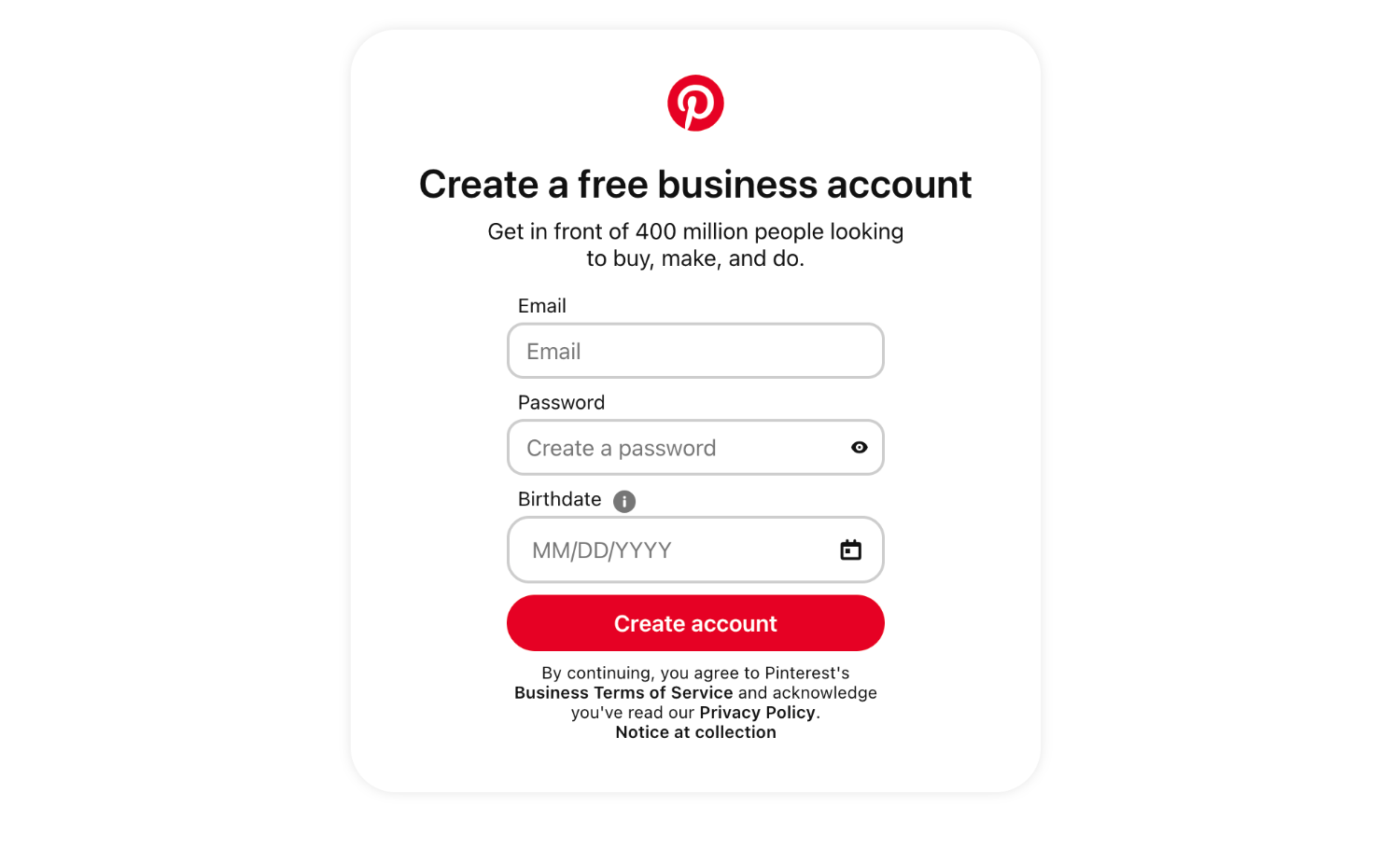
Here are the steps to set it up:
- Visit the Pinterest website.
- In the top right corner, click “Sign up.”
- Click “Create a business account.”
- Enter your email, new password, and birthdate.
- Click “Create account.”
- Follow prompts on the next few screens to build your profile and describe your business.
- Click “Done” and proceed to business manager to complete additional details.
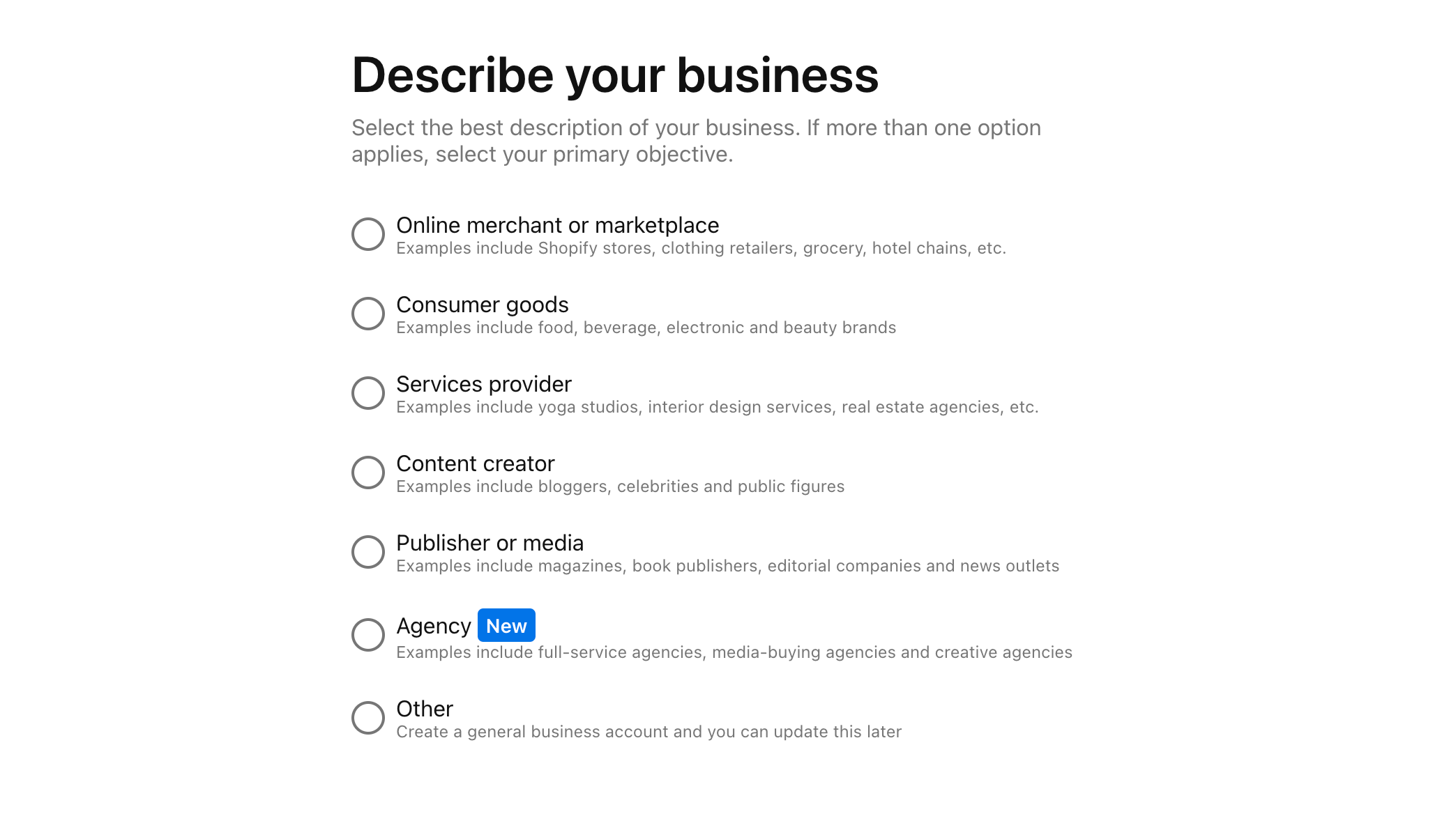
Your Pinterest business account is now ready to use. Access business features from the Pinterest business hub in the main menu. Later in this article, you’ll learn how to sell on Pinterest by syncing your account with your online store and using Pinterest ads.
Add a business account to your existing profile
If you already have a personal Pinterest account, you can create a new business account with your professional email and attach it to your profile. Follow these steps:
- While you’re logged into your personal account, access the menu from the top right corner of the screen.
- Select “Add account,” then choose “Create a free business account.”
- Follow the instructions from the last section to complete setup.
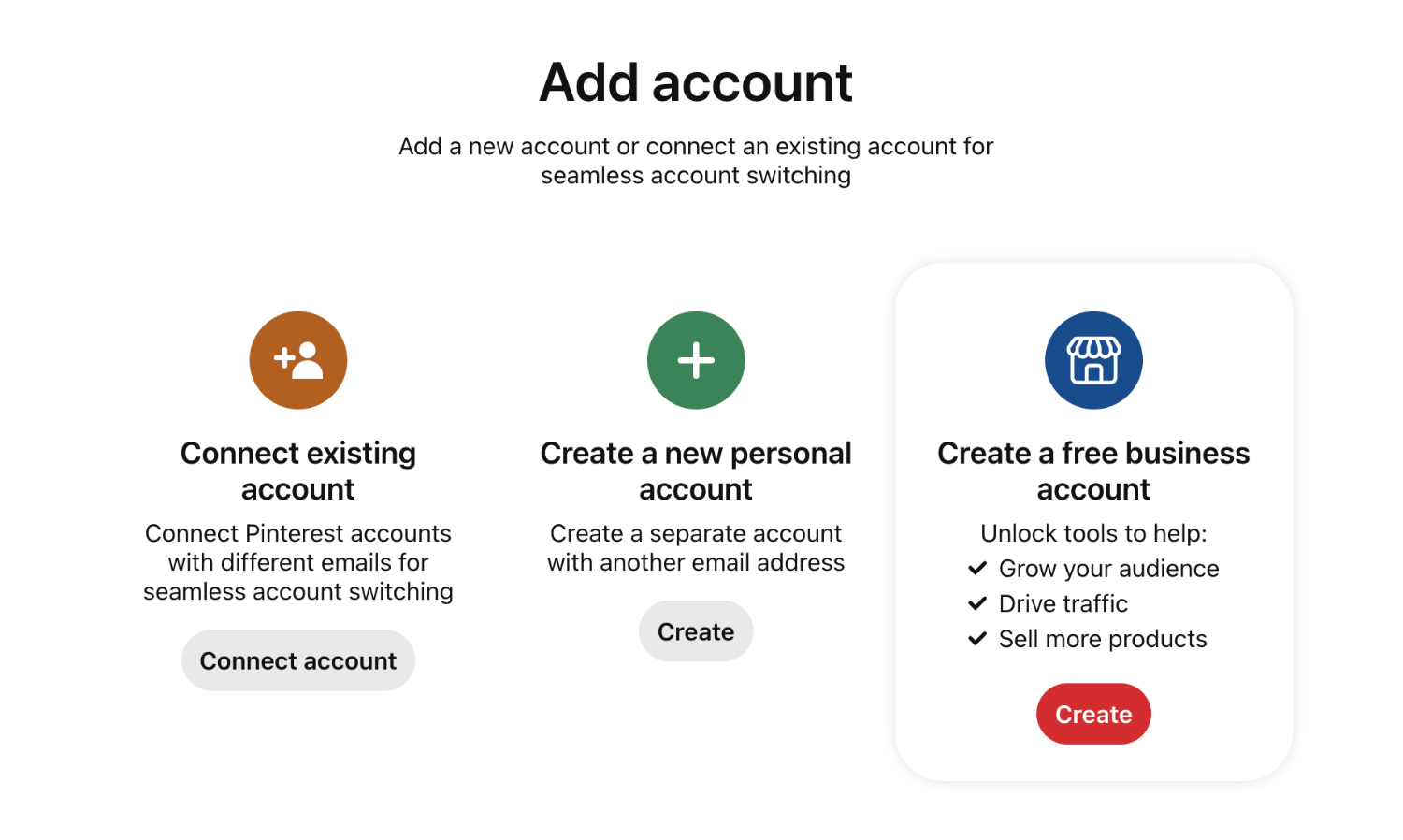
After you have set up your new account, you’ll be able to toggle between the two by accessing the menu in the top right corner of the screen.
Convert your personal account to a business account
If you’ve already built an audience using your personal account and it’s a fit for your business (say, you have a popular personal brand or your name is also your business name), you can convert your personal account into a business account. Doing so will retain your posts and followers so you don’t need to grow Pinterest followers from scratch.
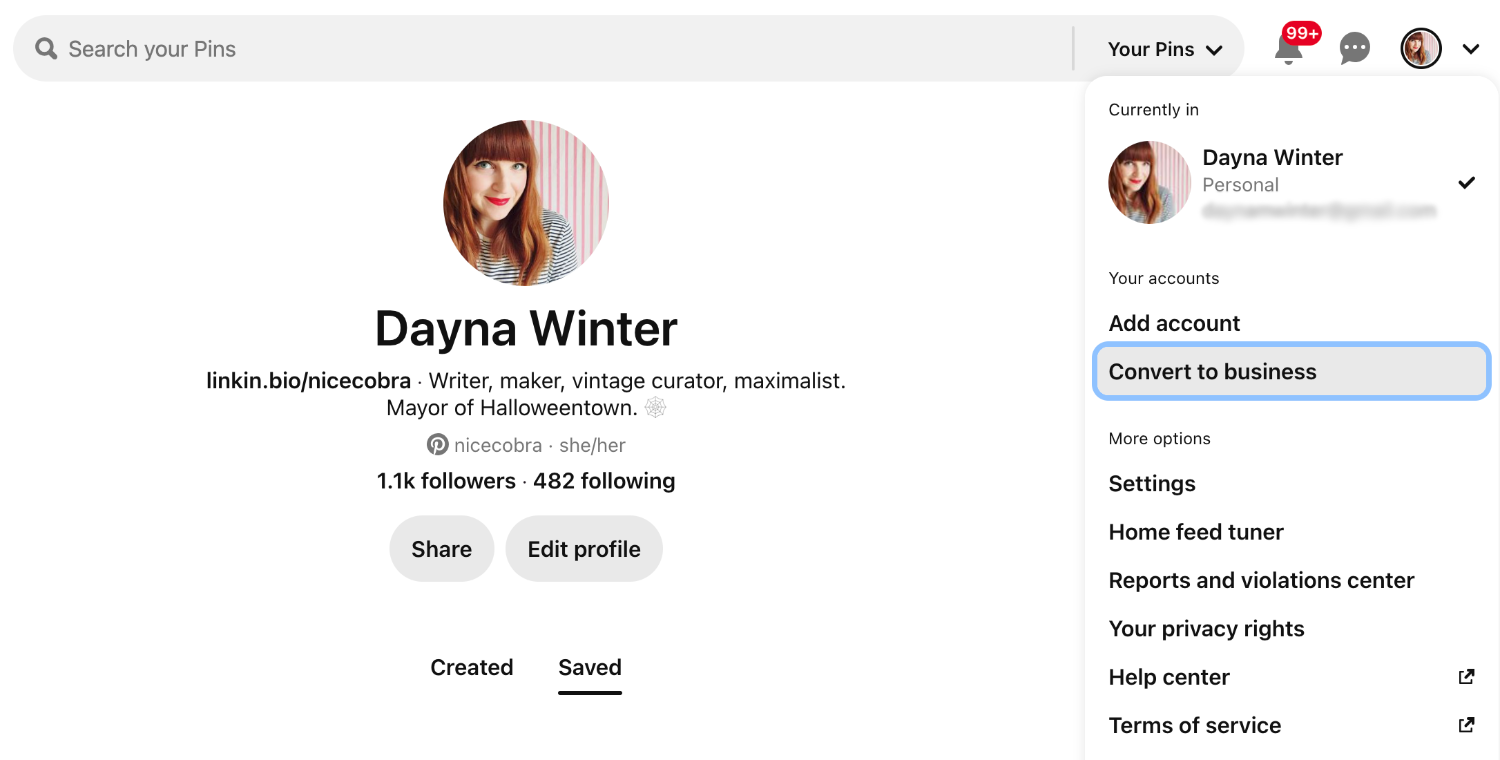
Here’s how to do it:
- While you’re logged into your personal account, access the menu from the top right corner of the screen.
- Click “Convert to business.”
- Follow prompts on the next few screens to build your profile and describe your business.
- Click ”Done” and proceed to business manager to complete additional details.
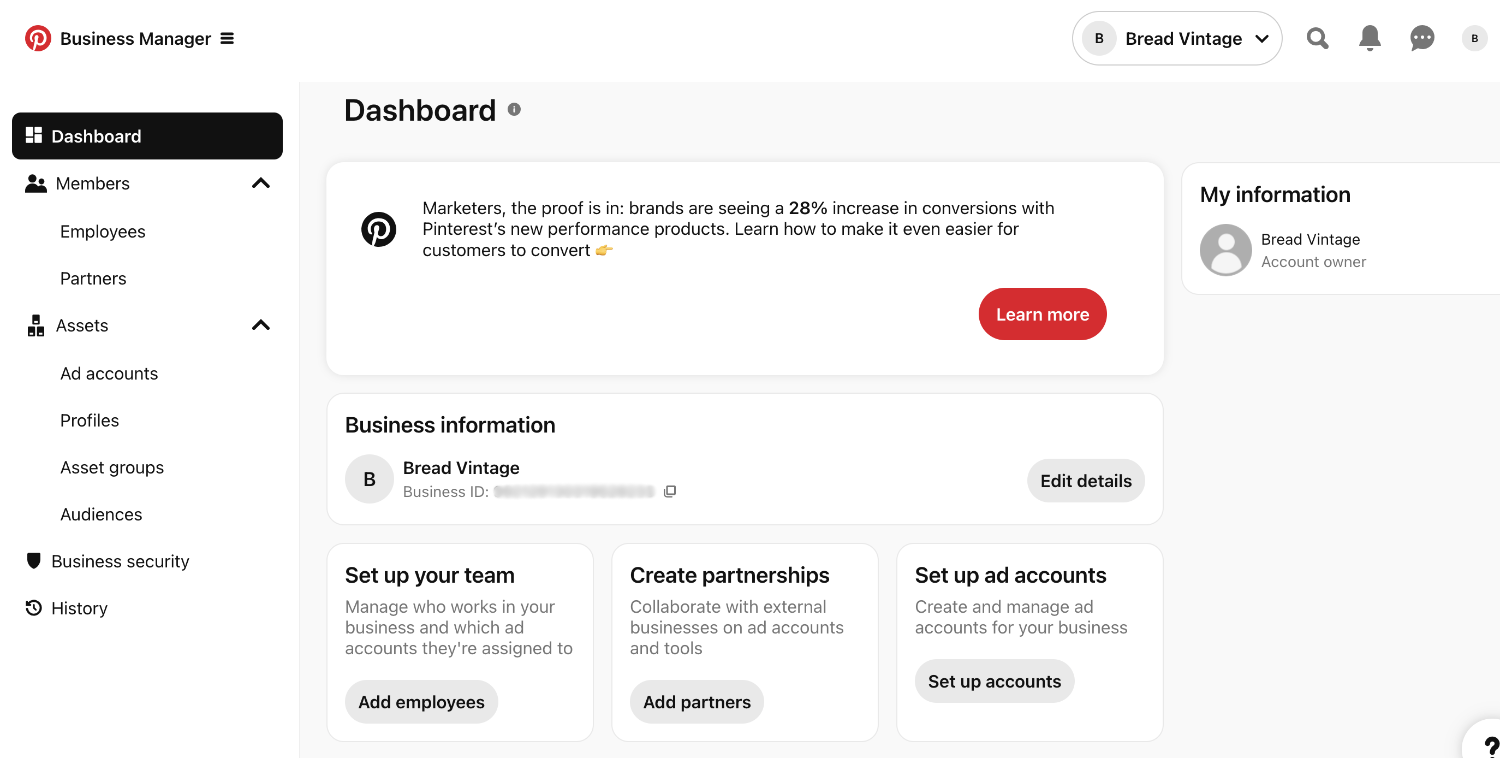
Note: You can reverse this change later if you choose to convert back to a personal account and create a separate business account.
How to get started selling on Pinterest
You can start selling on Pinterest in one of three ways. The first, and best for most small business owners already selling online, is to connect Pinterest with your online store via an integration app. Learn how to do this for your Shopify store later in this section.
Otherwise, you can upload your product feed to Catalogs by installing the Pinterest tag on your website and uploading your products to Pinterest. For larger retailers, use the Pinterest API to create and manage your catalog. This is an advanced option that requires specialist knowledge.
Note: You can still use rich pins and Pinterest Ads to drive sales for your business without directly connecting your store.
How to sell on Pinterest with Shopify
Link your Shopify store and your Pinterest account to promote the products on your website via the platform. While you can manually add the Pinterest tag to Shopify, as described above, using the Shopify Pinterest integration is a more straightforward approach.
The Pinterest Shopify app simplifies syncing your online store and inventory with your Pinterest account. When you integrate using the app, you can quickly publish product pins, create ads with a free credit, and track performance with the Pinterest tag. Plus, your product catalog will automatically update as you add or remove products from your website.
To connect: Go to the Shopify App Store and find the Pinterest Shopify app. Click “Install” and follow the prompts to set it up.
9 best practices for selling on Pinterest
- Brand your Pinterest account
- Focus on high-quality visuals and content
- Use Pinterest catalogs
- Organize content into Pinterest boards
- Use rich pins
- Explore collection pins
- Leverage Pinterest SEO
- Try Pinterest Ads
- Engage often
Ready to make your first sale on Pinterest? Here are some tips to help you make the most of your Pinterest account and reach your target audience of Pinterest users.
1. Brand your Pinterest account
Treat your Pinterest profile as you would any other surface where your brand shows up. Be sure your bio, username, business name, and avatar all follow your brand guidelines and accurately describe your business.
These steps legitimize your business and help you earn confidence with Pinterest users looking to buy a product like yours. These two examples from Bushbalm and Kopari both use copy and visuals to instantly tell a visitor what they’re about.
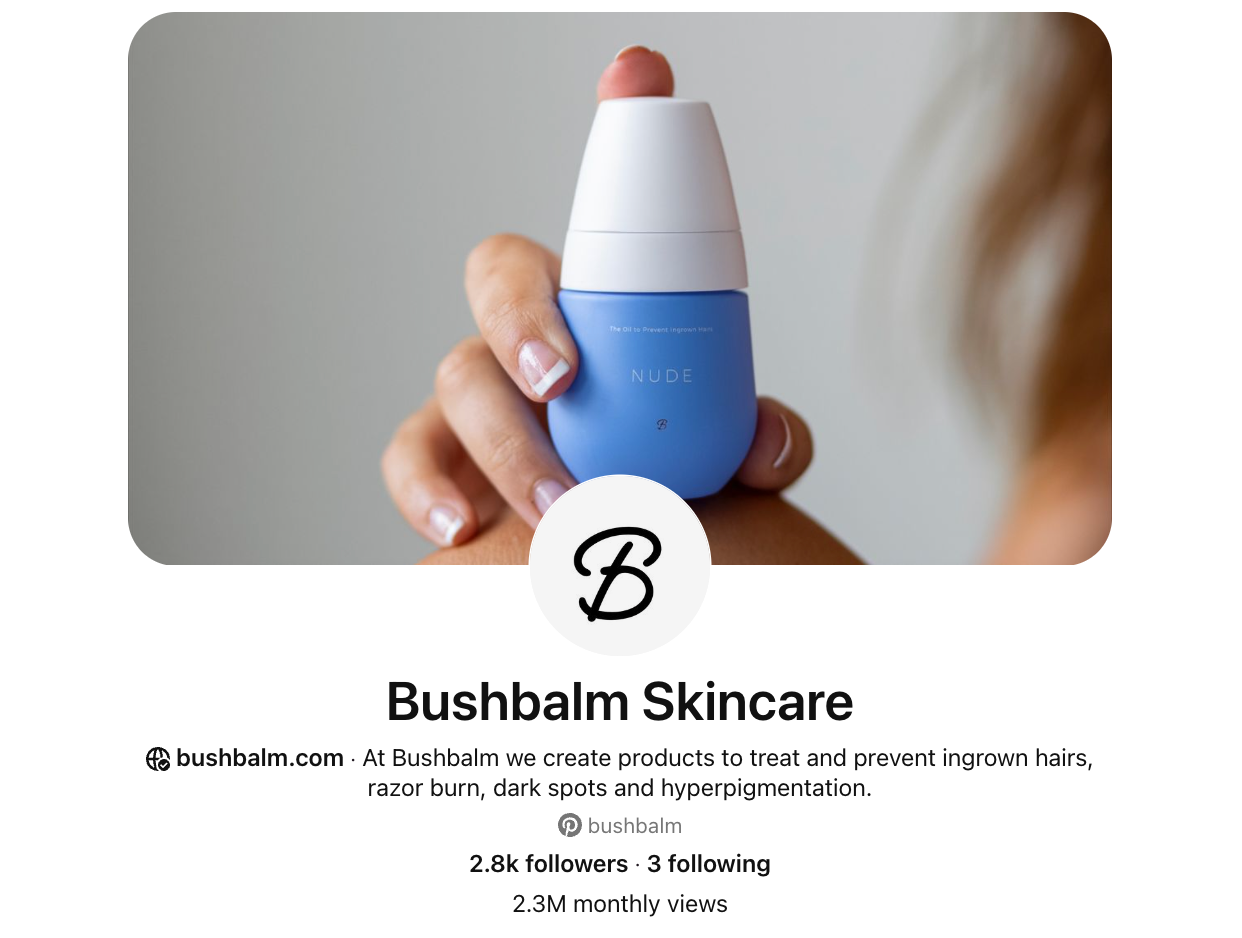
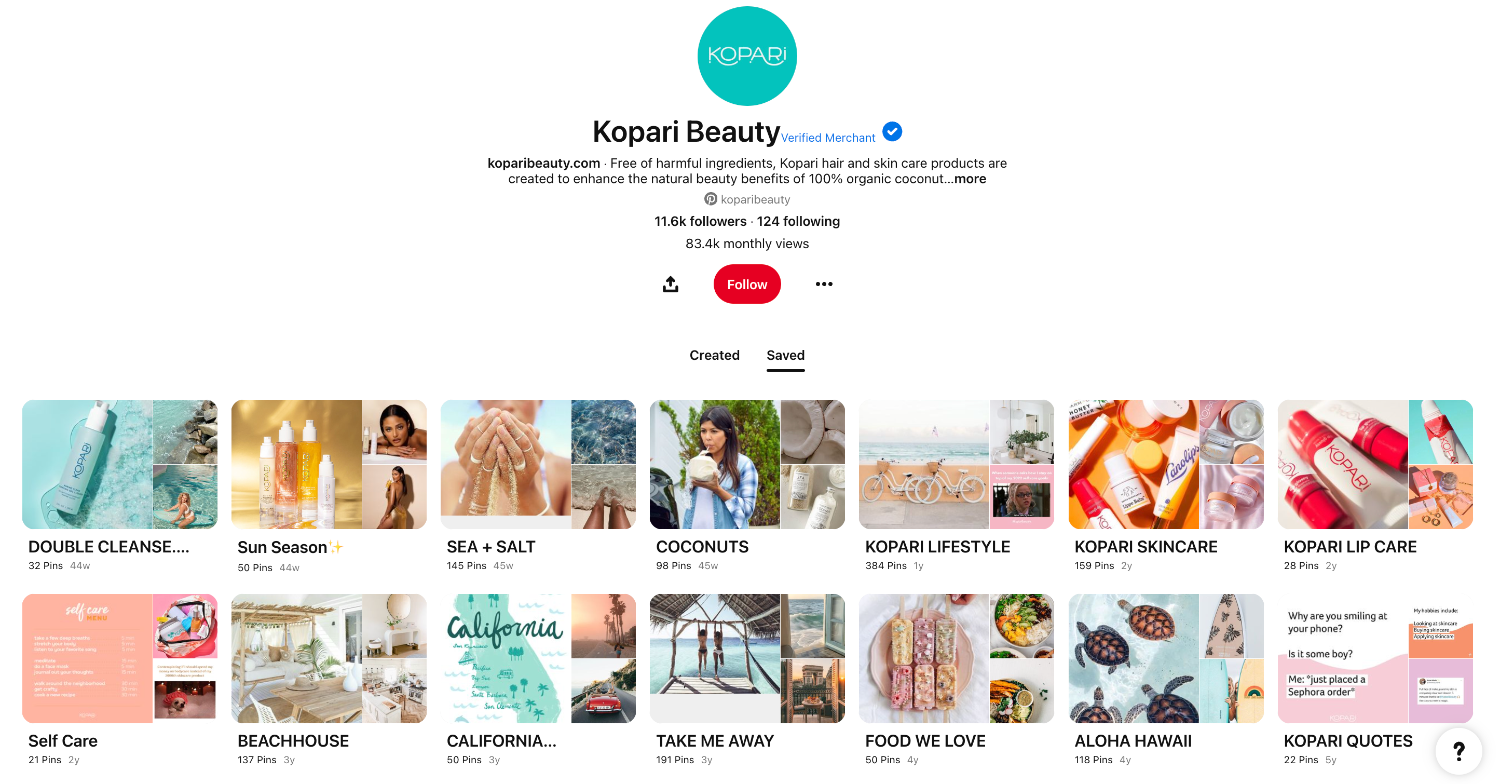
Verify your business profile
Go a step further with your profile by becoming a verified merchant. To qualify for the Verified Merchant Program, you must have a business profile, products that meet platform guidelines, and a Pinterest account that’s been active for 13 months.
Advantages of the program include a verified badge on your profile, merchant values tags, and access to additional shopping features like pricing and availability information on every product Pin.
In this example from Doe Lashes, “Asian-owned” and “Personal touch” are value tags available to the brand through the verified program.
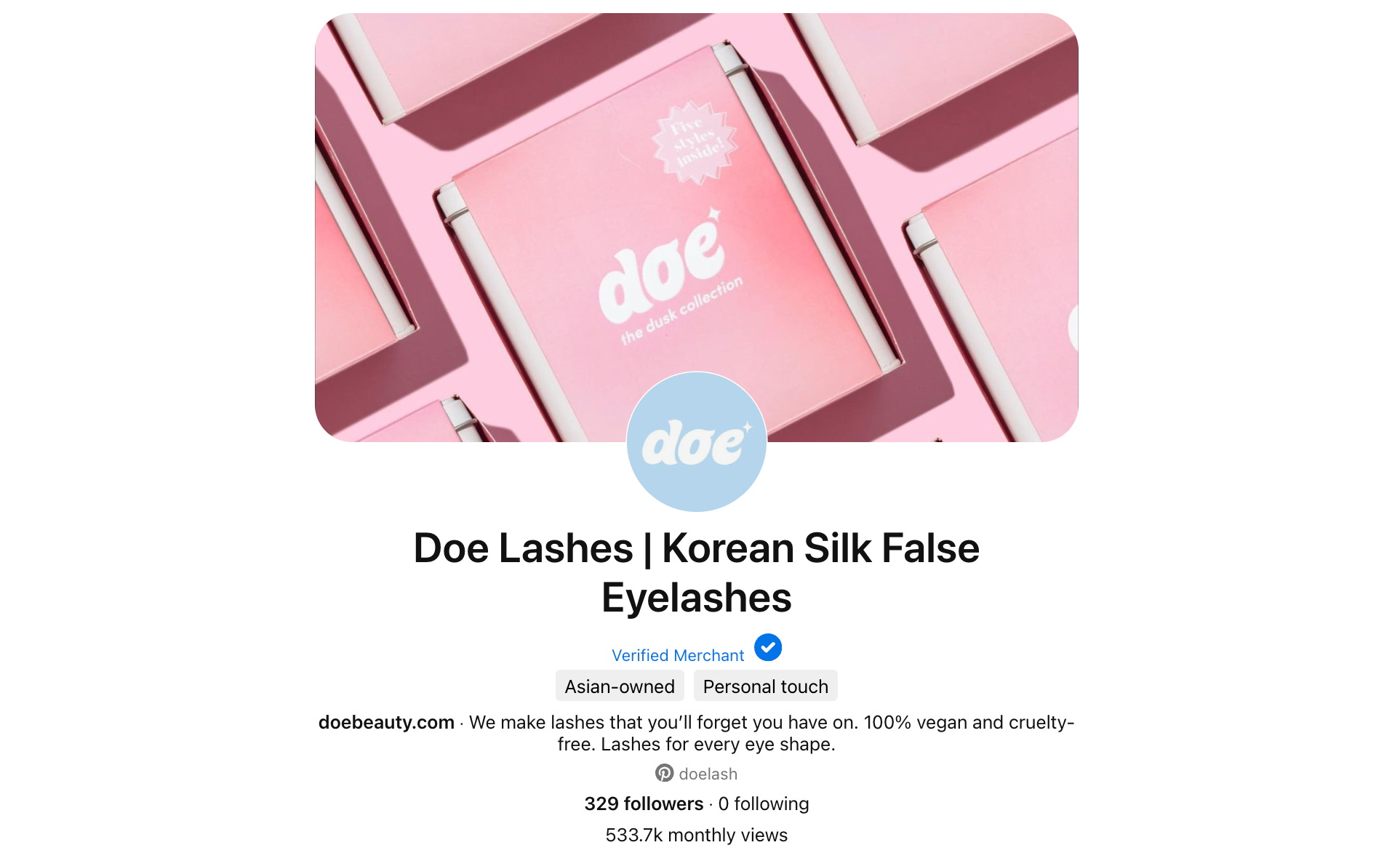
Tip: Pinterest’s business blog has insights to help you thrive on the platform. Alongside its Pinterest Predicts report, it also publishes color trends to guide your creative.
2. Focus on high-quality visuals and content
Pinterest is a visual search engine. That’s why high-quality product visuals including photography, video, and graphics are digital marketing essentials for this channel. When users search for products and ideas, catchy imagery will draw their attention.
Pinterest recommends the following for pin creative:
- Vertical images work best at a 2:3 aspect ratio, ideally 1000 pixels by 1500 pixels in size
- Include your logo or other brand signals (especially on Pinterest Ads)
- Add a caption, call to action, and link to every pin
This example from Blume includes brand signals, graphics, and copy over a captivating image. Both the caption and the text overlay have a strong call to action (CTA) as they promise to add value for the pinner.
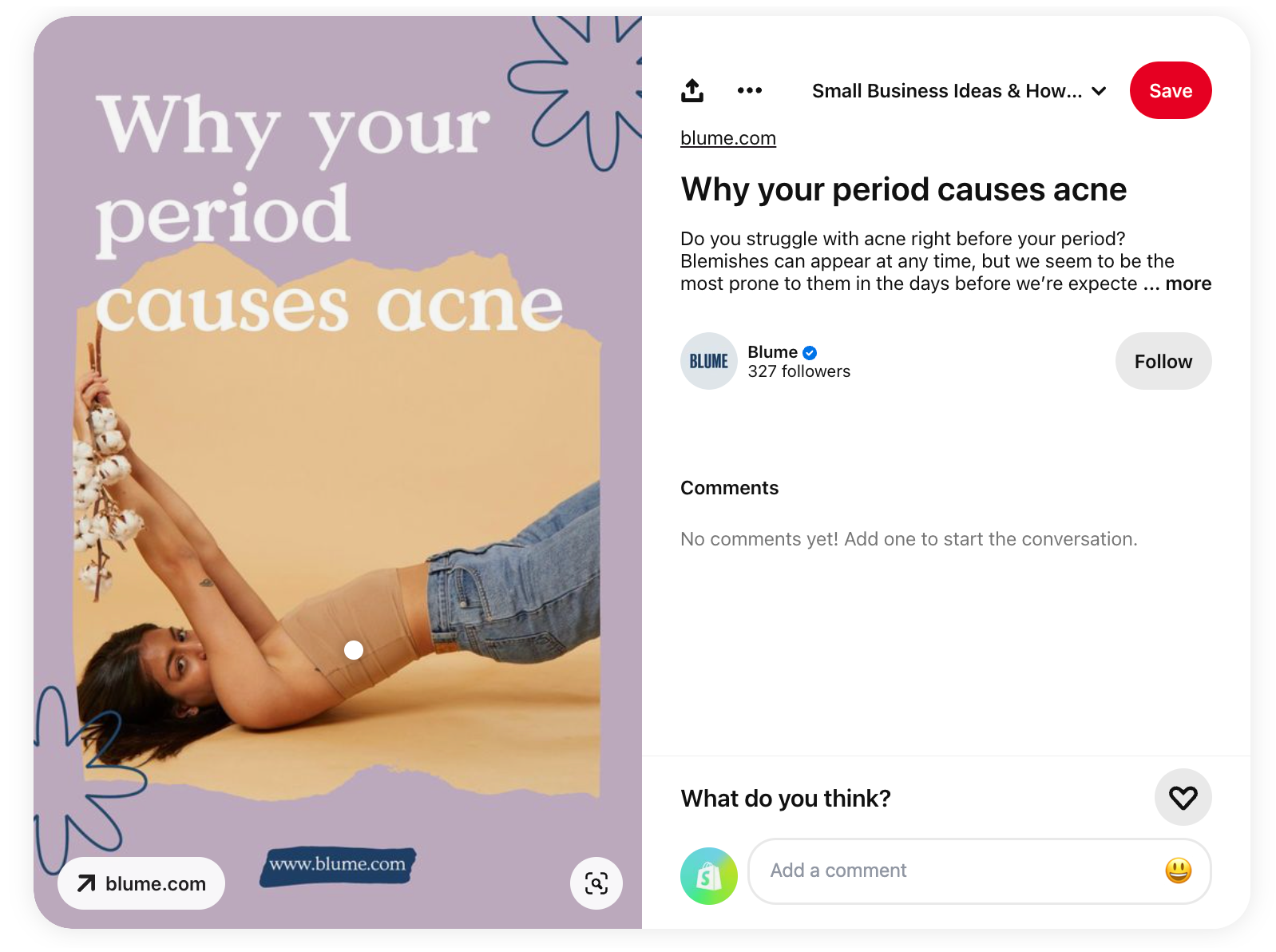
Pinterest demands a creative and visually appealing approach, even if your products aren’t visual in nature. Users build boards around moods and aesthetics, so make sure your visual content is inspiring rather than overly salesy.
This example from Caraway includes its products in an aspirational lifestyle photo that could live on any dream kitchen board.
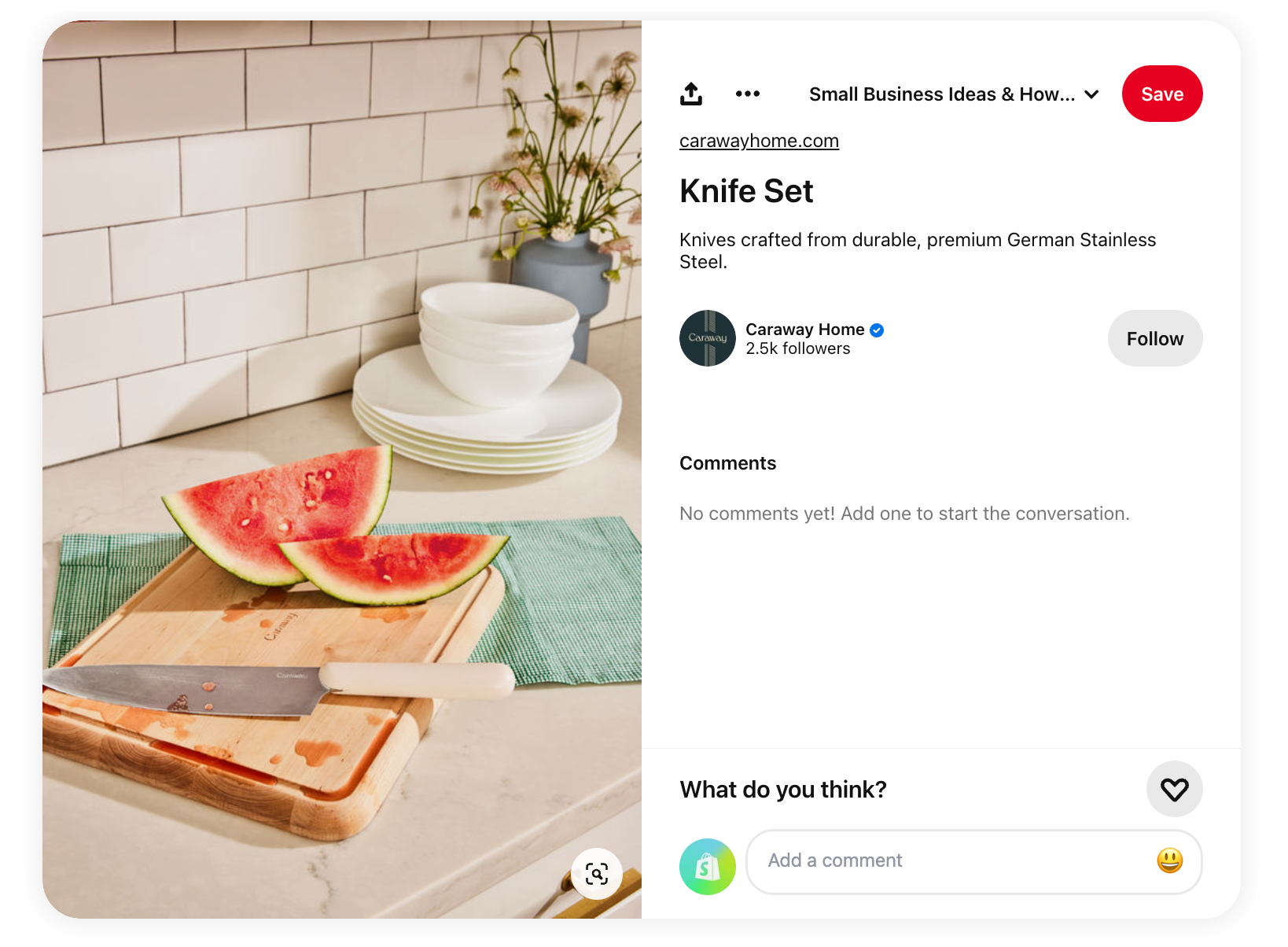
3. Use Pinterest catalogs
Pinterest catalogs is the platform’s main shopping feature. Catalogs allows you to import your store’s products into pins along with pricing, availability, and a direct link to buy. These are called product pins. Here’s an example from Herschel Supply that shows how your product information will look in a product pin:
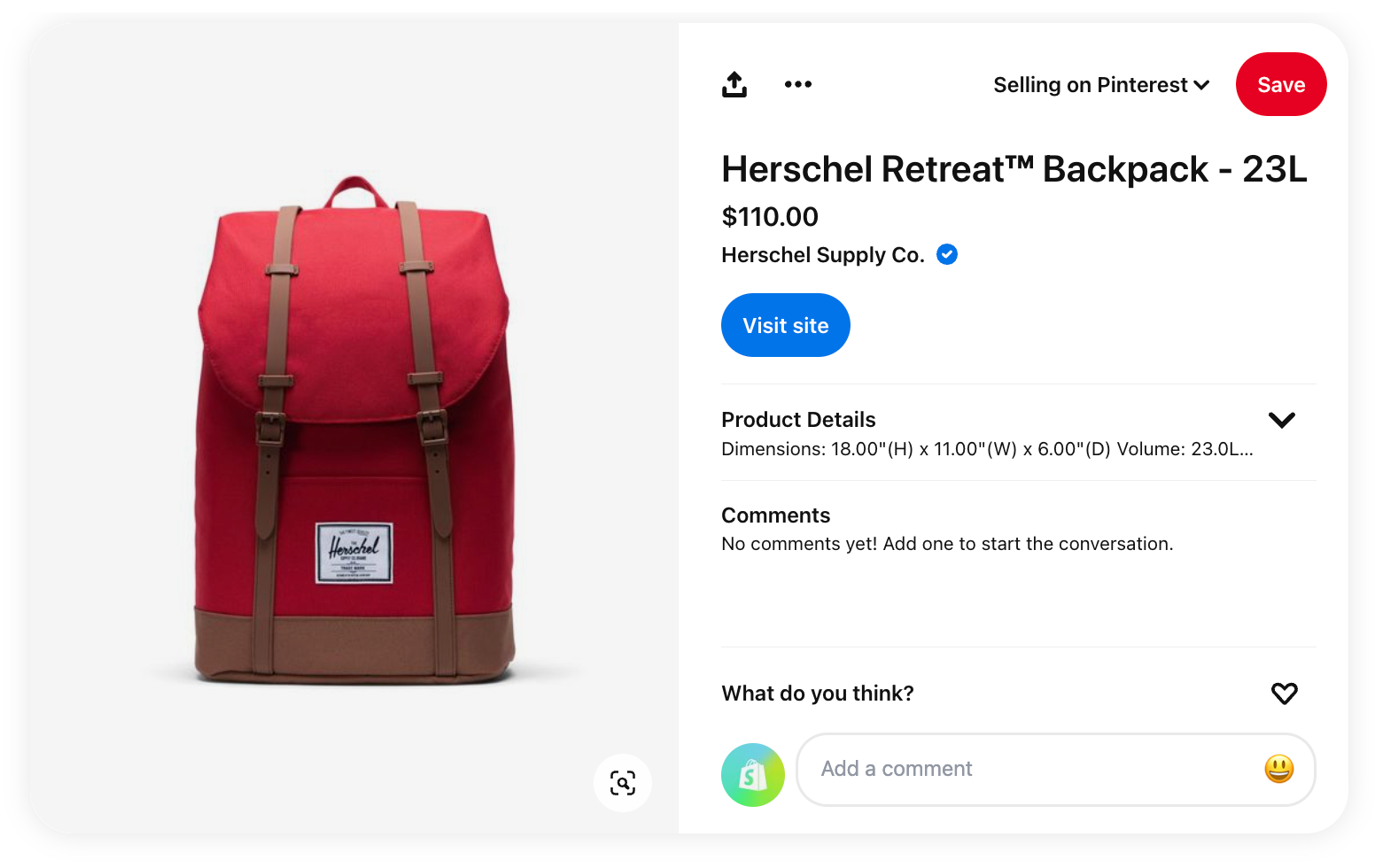
Product pins also get priority placement at the top of searches. In this search for “running shoes,” you can see a row of product pins under the header “Shop running shoes” before the rest of the results.
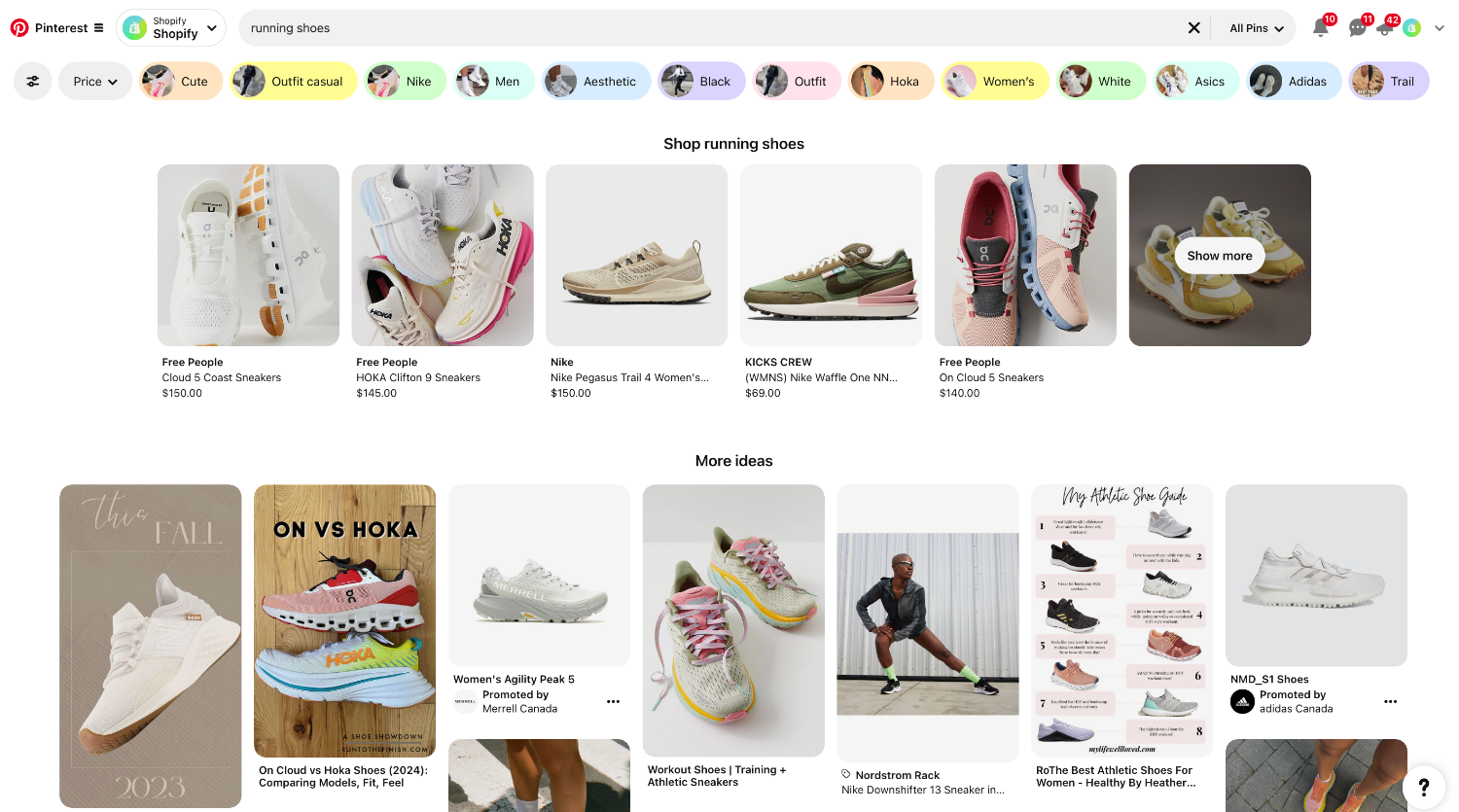
How to qualify for Pinterest catalogs
Pinterest catalogs is a feature available to business accounts with a claimed website and business practices that meet Pinterest’s requirements. These include having a compatible shipping policy and return policy, and availability of contact information. You also need to have a data source for your products—if you’re a Shopify merchant, that would be your Shopify store.
4. Organize content into Pinterest boards
Pinterest boards work as folders or categories for your collection of created and curated pins. Organize your boards so users can easily browse and engage with your pinned content. Boards can also boost your visibility in search if you optimize them for search terms relevant to your brand (more on that later).
Here’s a sample of boards by SPF brand Supergoop. The boards are organized by product type and theme, with a few educational boards mixed in. Educational content can support potential customers with their purchases and position your brand as an authority in your industry.
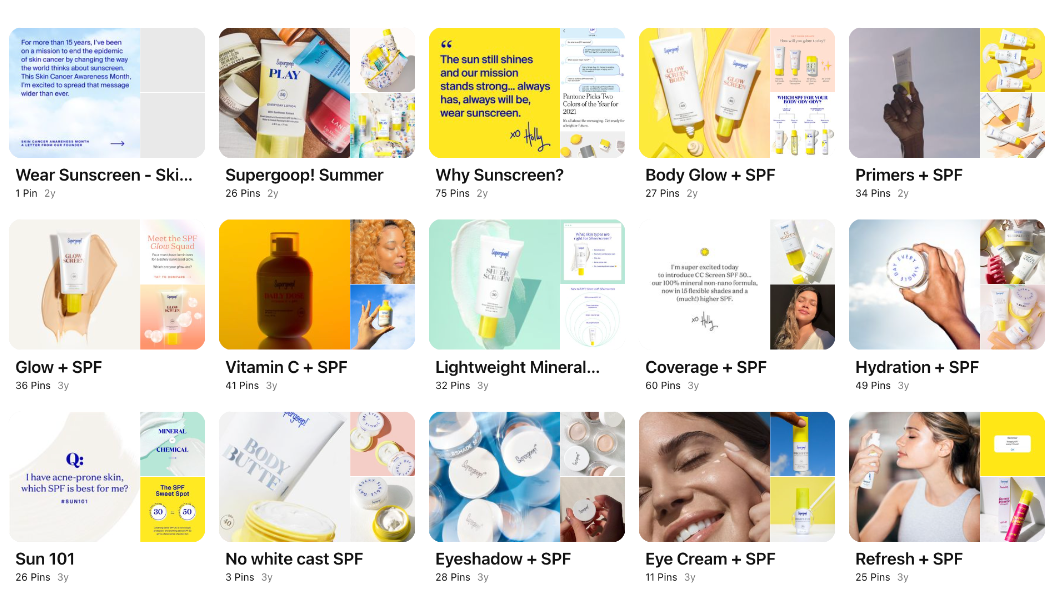
Notice how a consistent color palette makes the brand look cohesive. Inside its boards, Supergoop also puts its best foot forward, with graphics that use similar design elements:
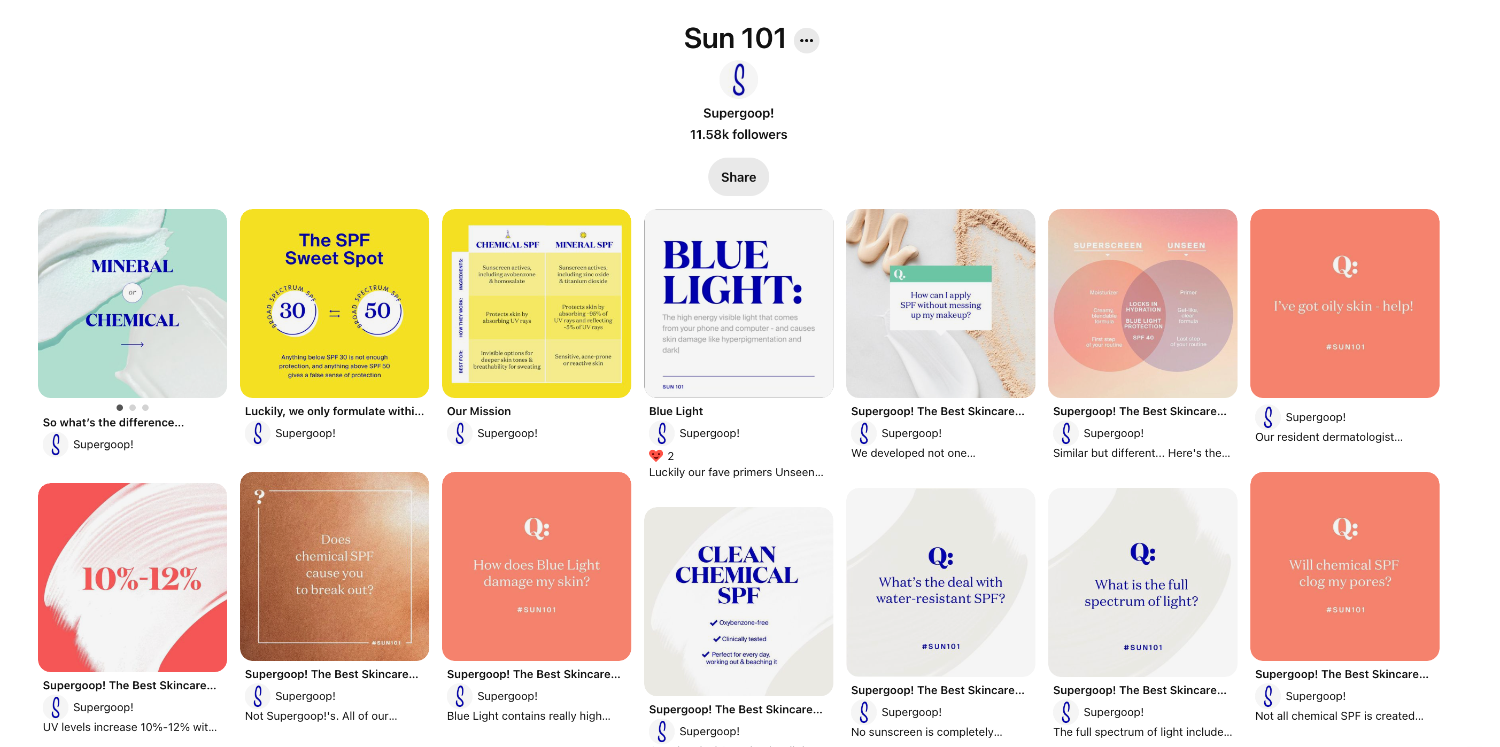
Even inside a product-focused board, Supergoop is careful not to overload the content with product pins. These live naturally among other helpful and on-brand content like demos and user-generated content:
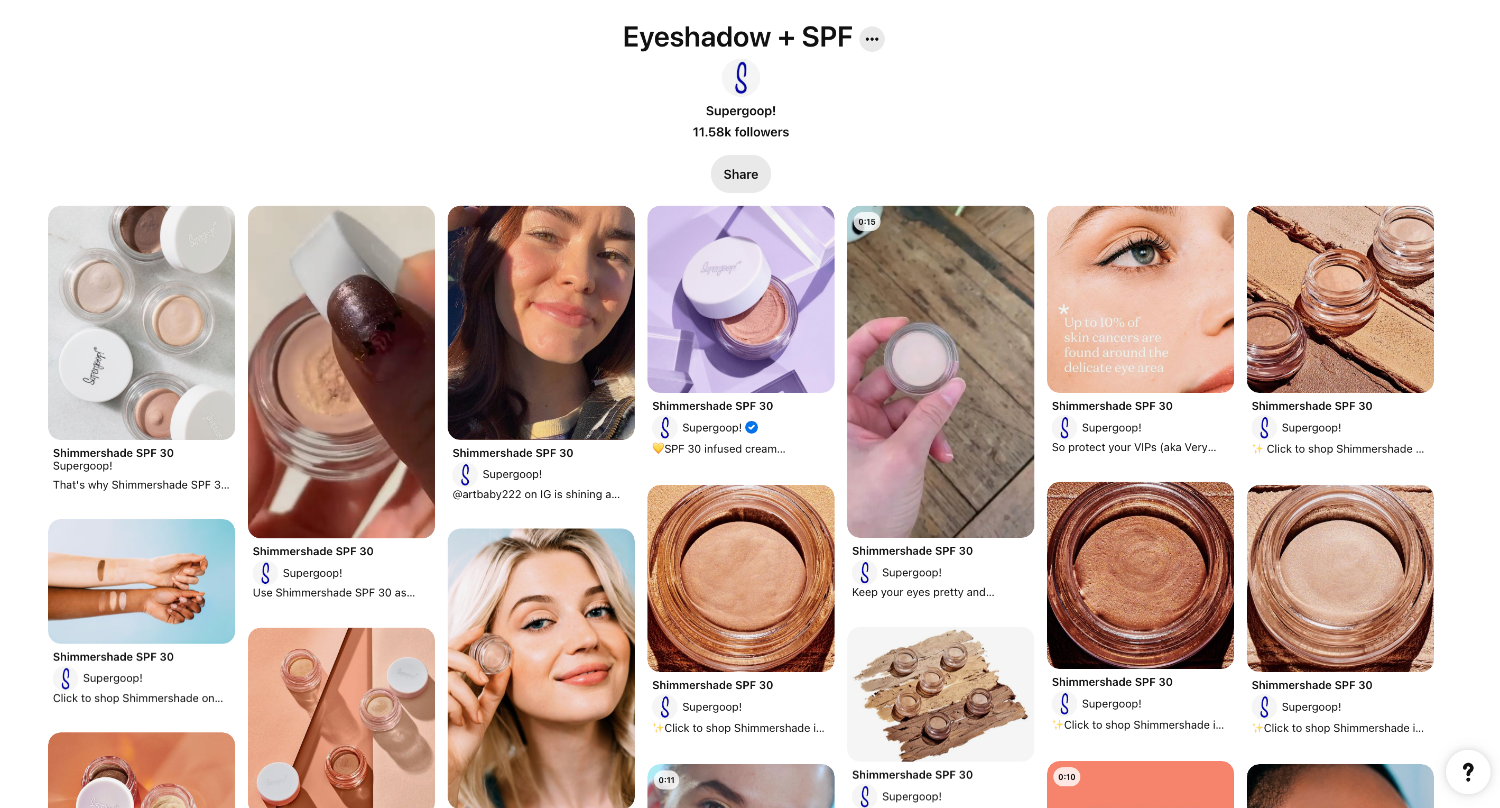
5. Use rich pins
Rich pins automatically sync with website data and display that data for users. There are three types of rich pins:
- Article pins: Article pins include the headline or title, description, and author of the article or blog post.
- Product pins: Product pins include pricing, availability, and product information.
- Recipe pins: Recipe pins include the title, serving size, cook time, ratings, diet preference, and list of ingredients.
While you’ve already learned about the benefits of product pins earlier in this article, other types of rich pins can be helpful as part of your content marketing strategy. For example, food brands can build value for potential customers with recipes that use their product. Here’s an example from Starbucks:
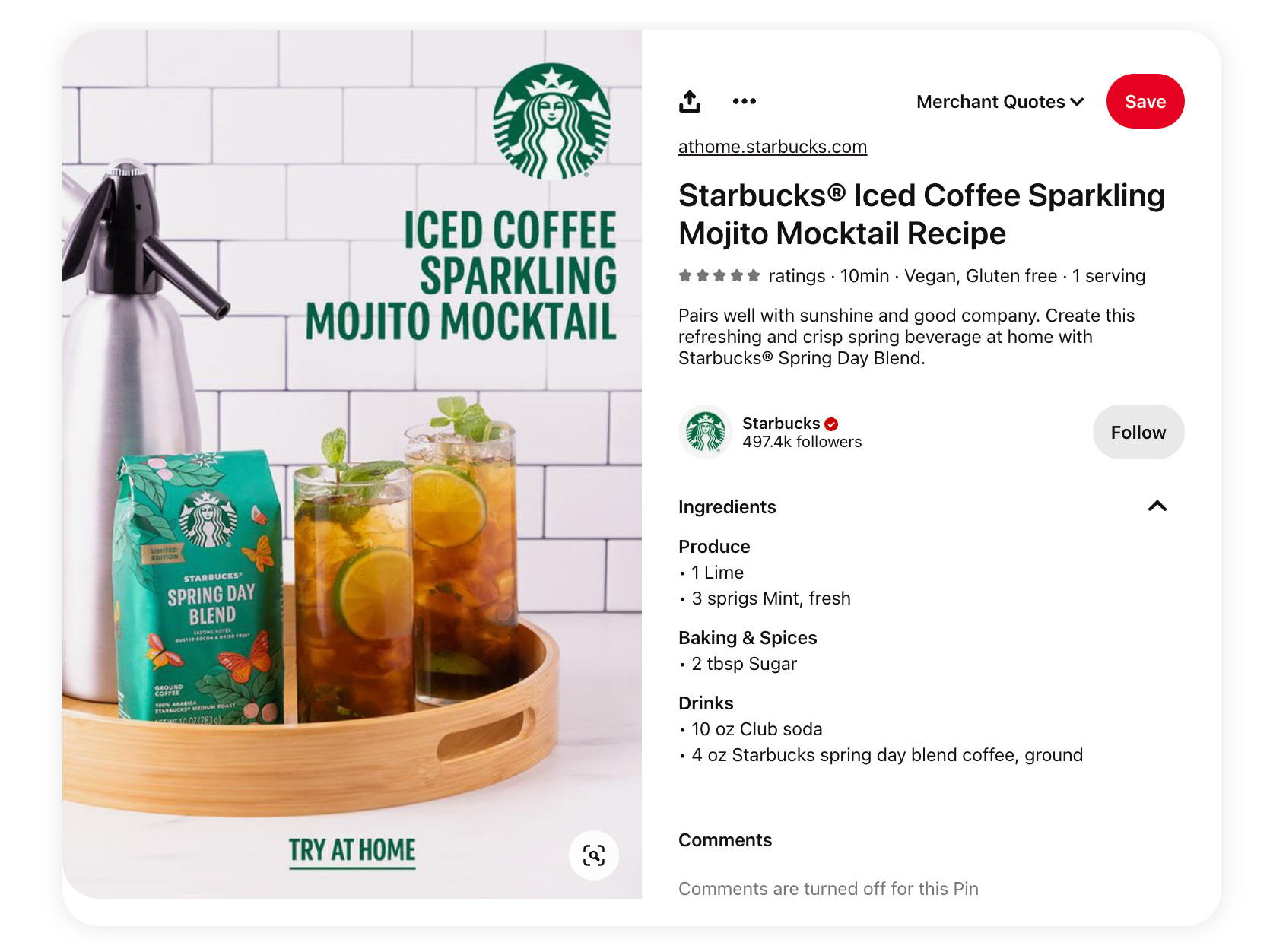
Note: Rich pins are especially valuable, as they don’t require any manual updating. If you update the information on your website, it will automatically update for your rich pins as well.
6. Explore pin formats
Collections pins are groups of product pins. When a user clicks on a pin in a collection, they can easily shop for similar or related products from your store. This is a great way to expose pinners to your brand. Collections pins can be promoted and converted to a collections ad.
Try on product pins use augmented reality (AR) technology to let Pinterest users virtually “try on” products they find on the platform. This feature can be enabled on product pins. You must have a business account and catalogs enabled to use this feature. It currently isn’t available in every market.
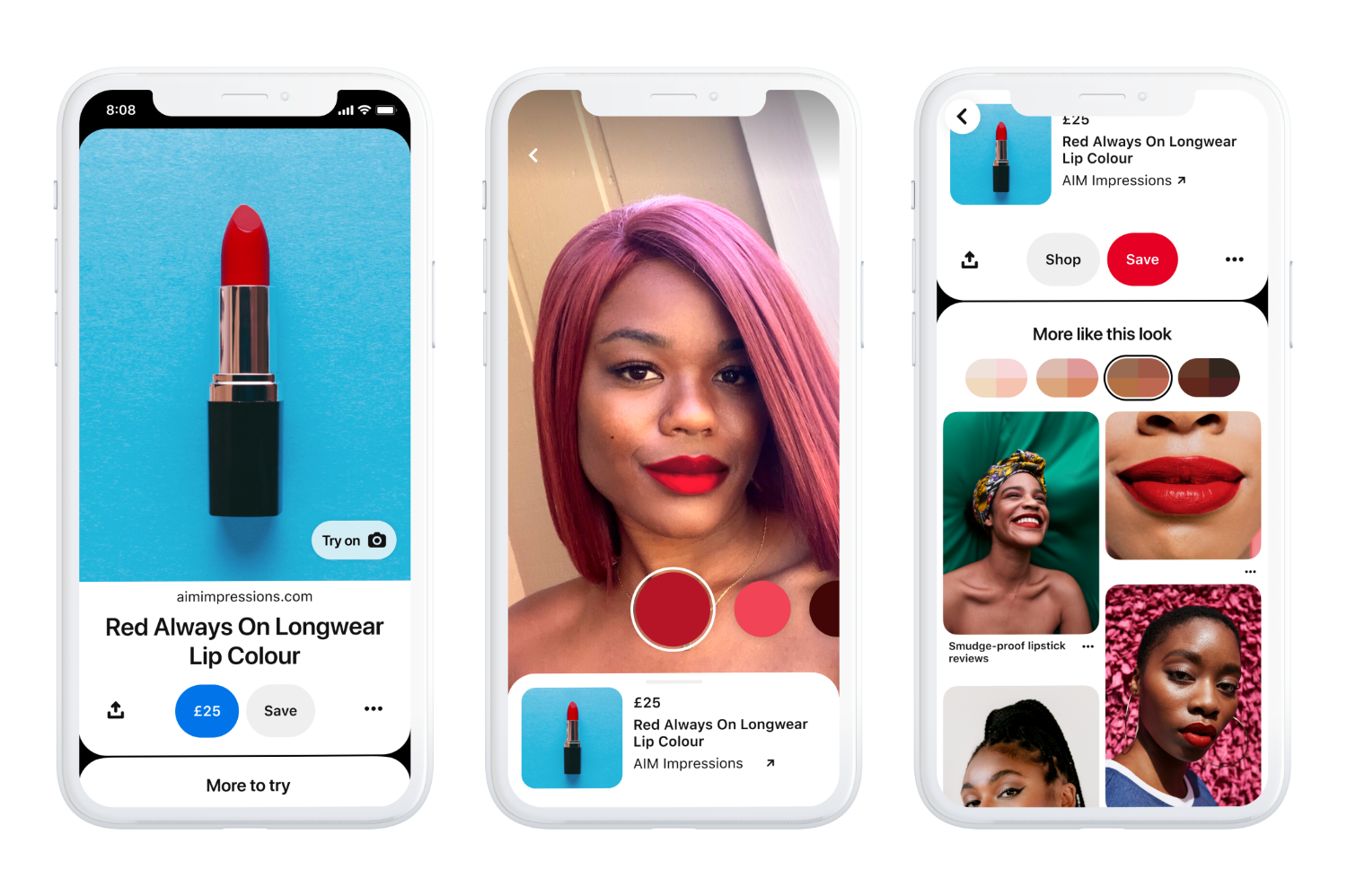
Pinterest
7. Leverage Pinterest SEO
Investing in search engine optimization (SEO) for Pinterest will boost visibility and traffic to your page and website. Keywords are a core component of Pinterest SEO, since the platform functions as a visual search engine. The higher you rank, the more people will see your content, engage with your pins, and discover your products.
You can use external keyword research tools to develop your SEO strategy, but Pinterest also offers a native keyword research tool. You can access this through the Ads platform by creating a campaign and choosing “Conversion” as your business goal. Enter keywords associated with your brand to see keyword search volume and related keywords.
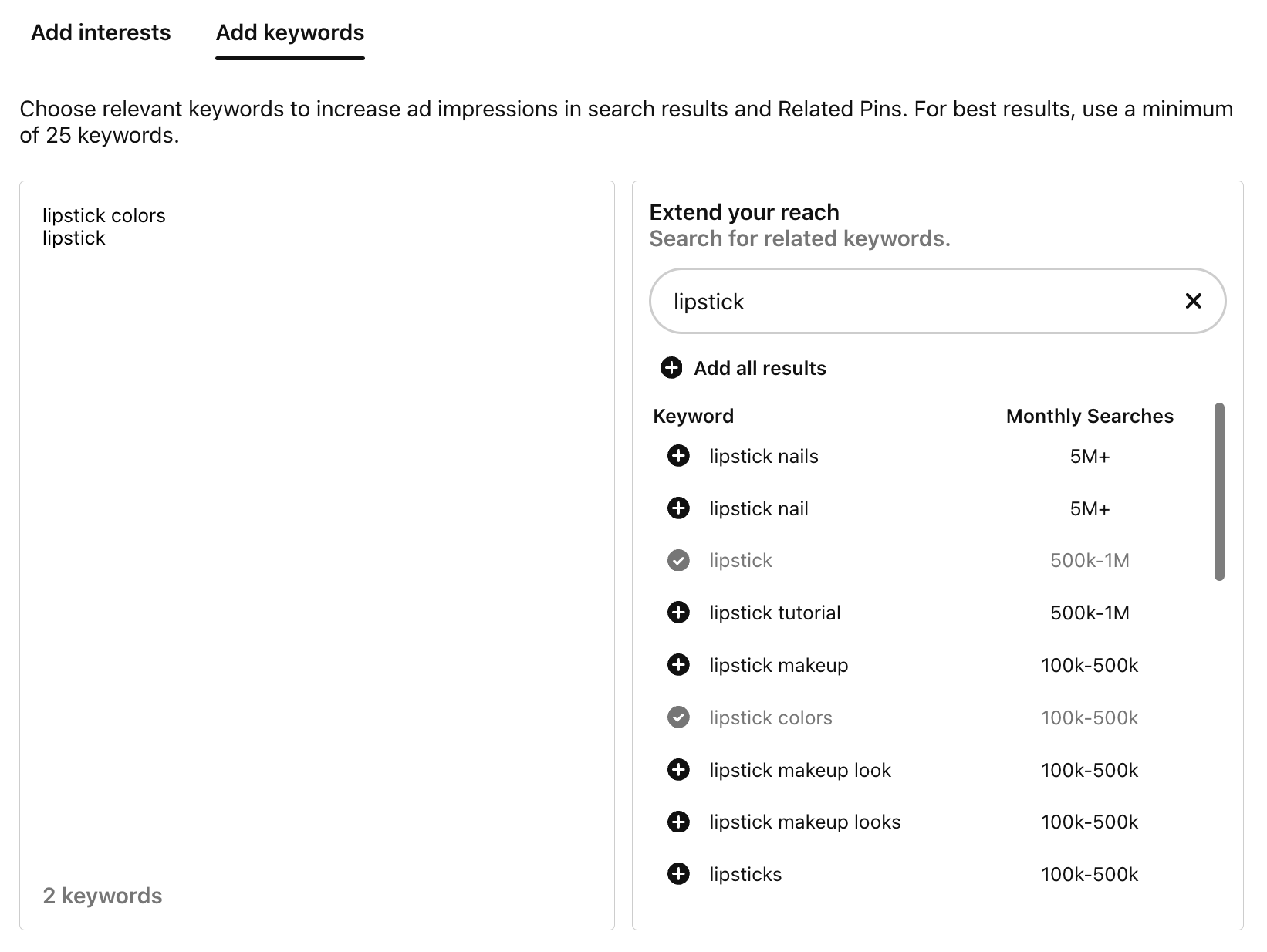
Find words and phrases relevant to your products and pins through the Pinterest search bar. Pinterest will auto suggest search queries based on Pinterest’s own historical search data. Typing a simple term into the search bar can give you ideas for long-tail keywords:

Once you’ve chosen your keywords, it’s time to use them. Understand what types of content people are looking for on Pinterest by looking at the top search results. This should help you choose images.
You can then optimize your pins by:
- Using keywords in pin titles and descriptions. Follow character and word count recommendations for each as you create your pins
- Using relevant hashtags in pin descriptions
- Putting pins in relevant boards with optimized titles and board descriptions
- Using rich pin formats
In the following examples, see how brands Girlfriend Collective, Rothy’s, and Pair Eyewear use descriptive text, keywords, and hashtags to optimize their pins:
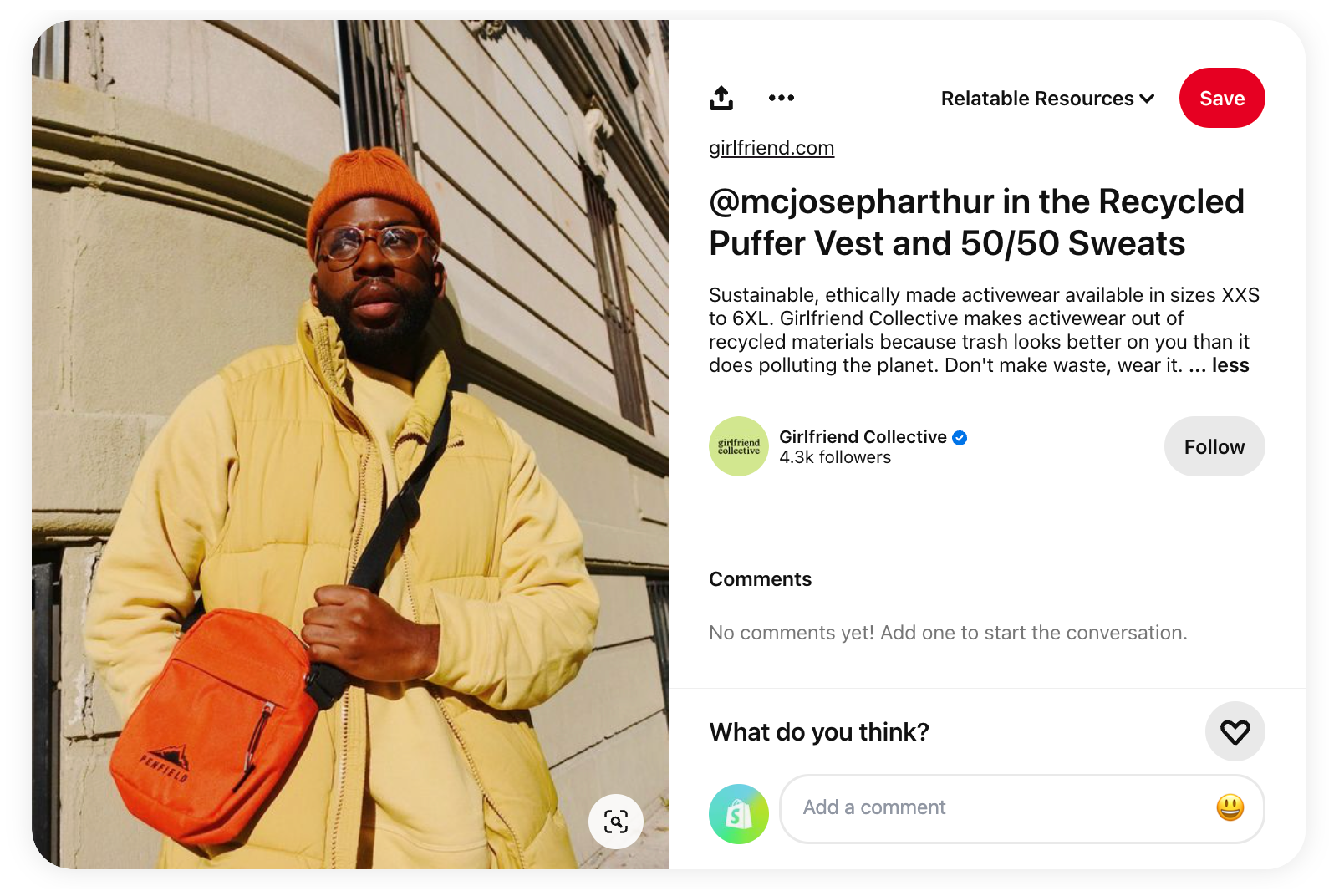
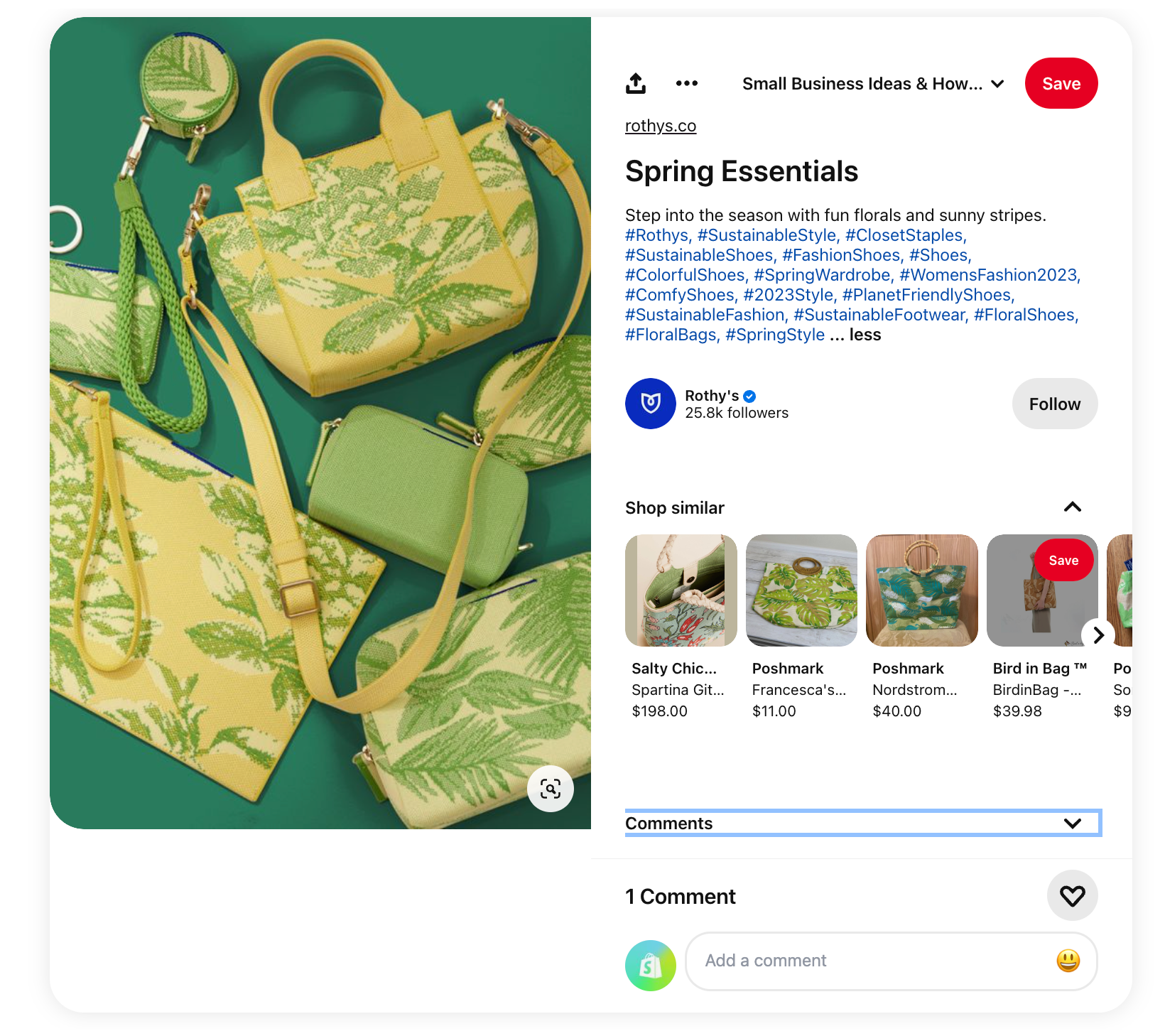
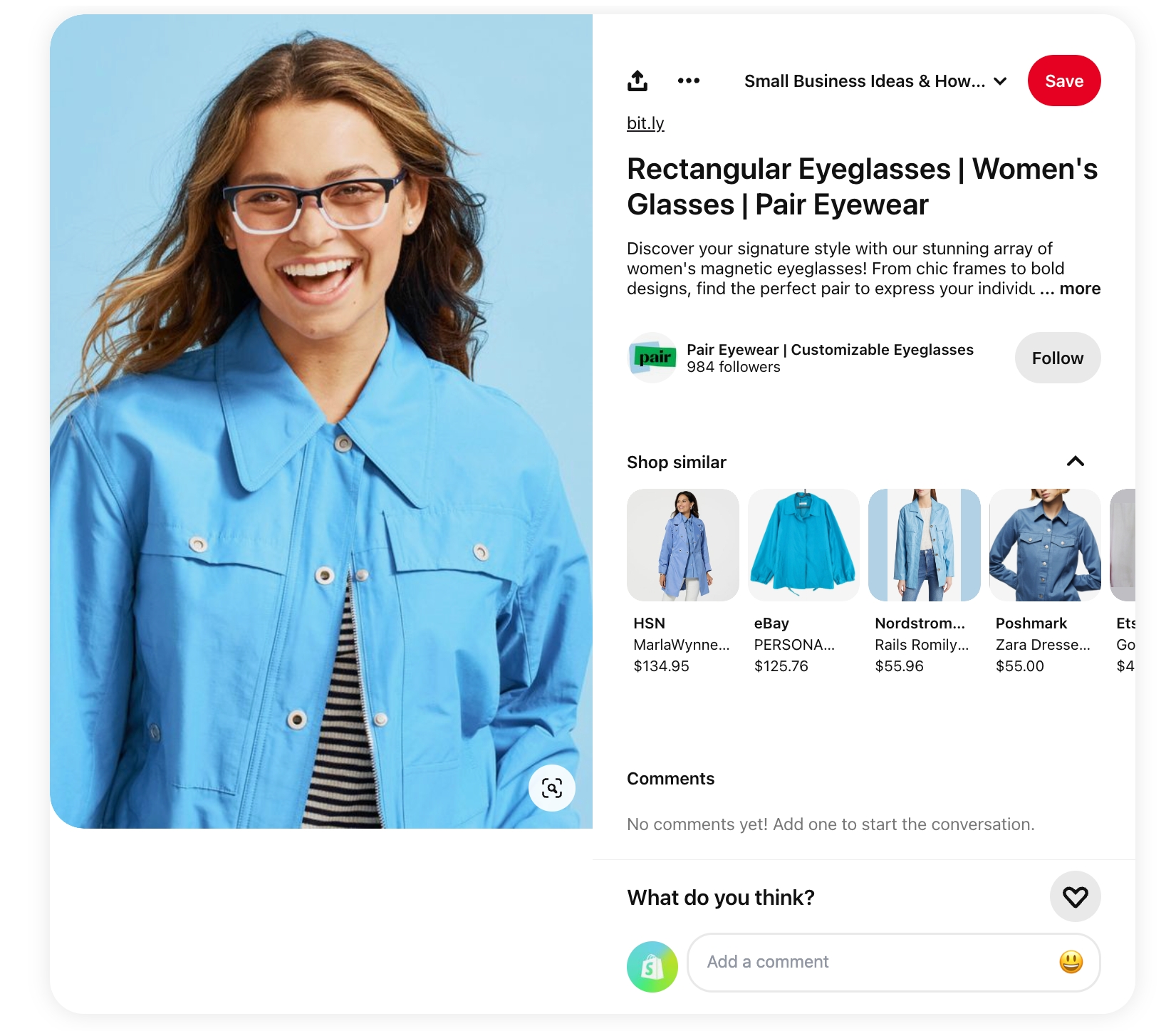
“Pinterest is this strangely powerful hidden tool that I don’t think a lot of people are using,” says Dan Blacklock, founder of BoxThrone. “When you do a Google image search, a good 20% of the photos that show up are from Pinterest, at least from my product. That matters a lot in SEO.”
8. Try Pinterest Ads
Pinterest Ads are available to business accounts and can be a valuable marketing channel for your brand. There are a few types of Pinterest ads you can use depending on your content, products, and goals:
- Promoted pins look like regular pins but with a “Promoted by” tag above your username.
- Showcase ads are carousel ads where each image in the carousel can link to a different page on your website.
- Quiz ads are dynamic ads that allow you to poll your audience directly inside the pin. This is a great way to personalize the experience and send users to different pages, depending on the result.
- Shopping ads are designed to promote products to your target audience and can be formatted as a static image, video, or collections ad.
- Premiere spotlight is a new feature that shows edge-to-edge video in search and home feeds on mobile.
Again, if we look at search results for “running shoes,” you can see organic results mixed with promoted pins from Adidas, Saucony, and Merrell:
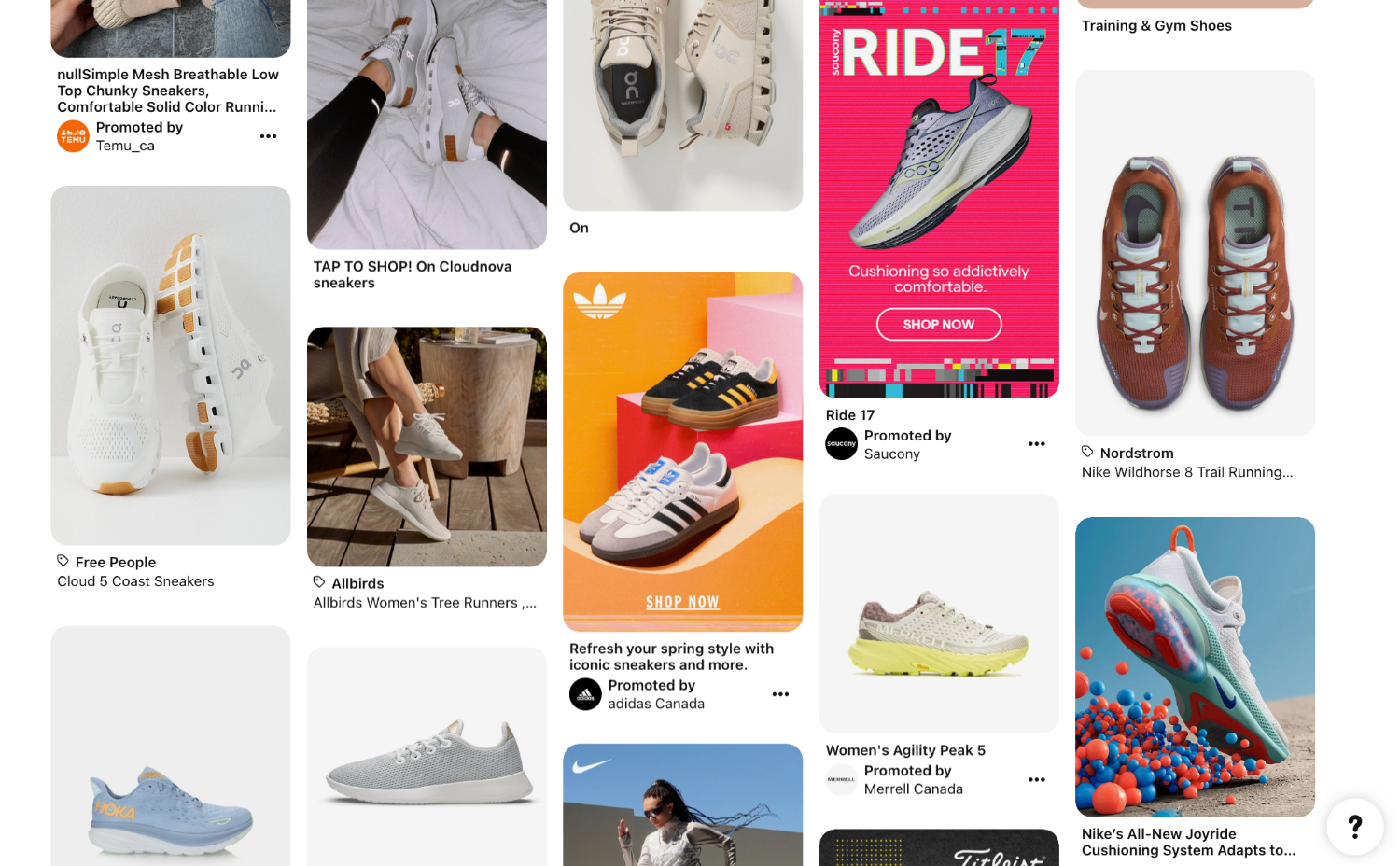
When you create ad campaigns, you can target customers based on audiences from email lists, demographics and location. To create even more targeted and effective campaigns, consider adding interests and keywords. To use this feature and launch the Ads platform, navigate to “Create campaign” from the main menu on Pinterest.
9. Engage often
As with any social media platform, your success is determined by how engaging your content is but also how you respond to that engagement. Pinterest should be considered a two-way communications channel, where your brand engages with its audience. Respond to comments, pin user-generated content, and post consistently to show you’re a brand that’s invested in its customers.
Track and analyze Pinterest performance
Pinterest Analytics provides valuable insights into how your account, pins, and ads are performing. You can also view specific metrics for your product pins.
Pinterest’s analytics allow you to toggle between organic and promoted content to measure results separately. A number of filters allow you to slice the information by date range, device, and type of engagement. In your analytics dashboard, you can also drill down to specific pin performance metrics. Learn about trends and audience insights, too, by exploring the links in the left navigation bar.
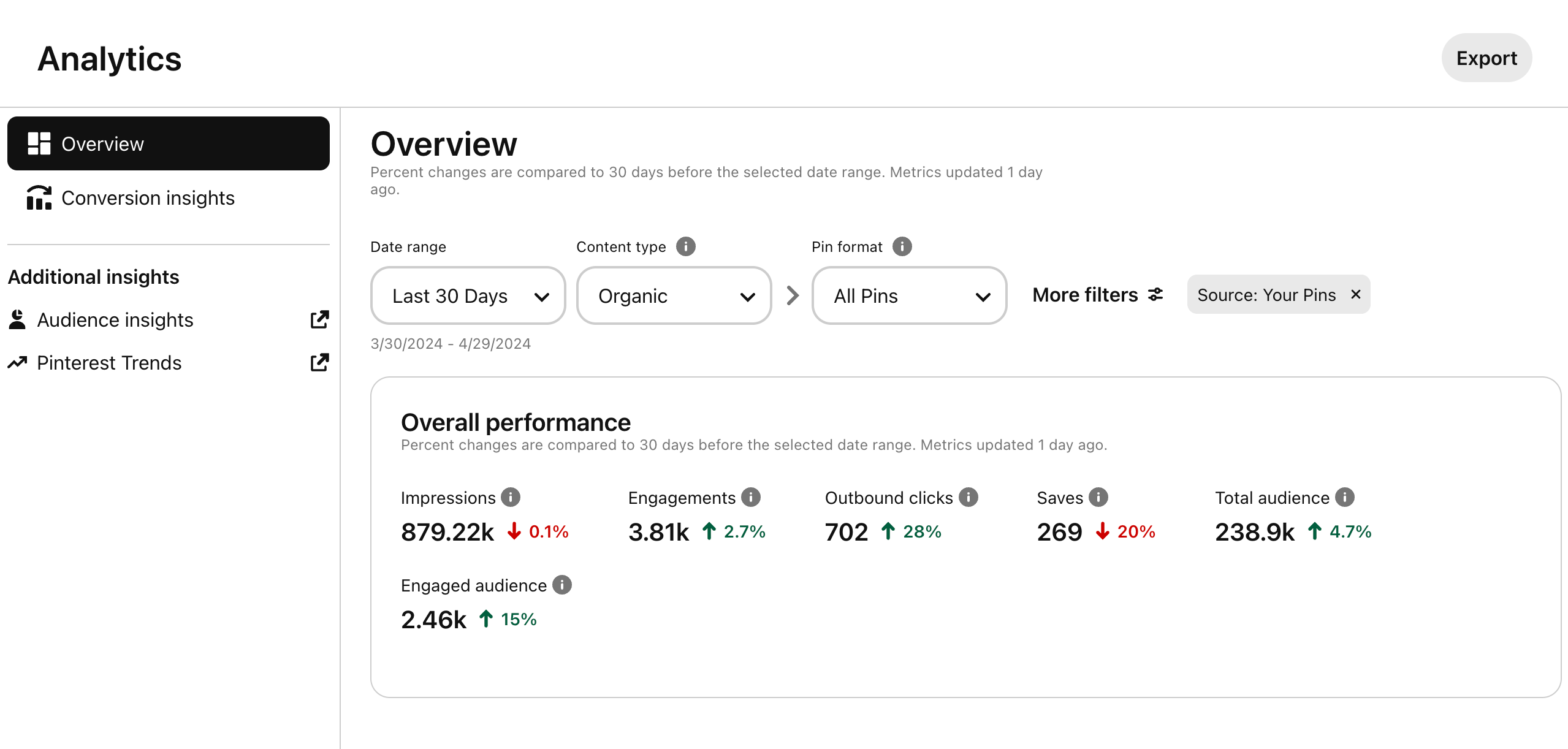
Note: In addition to Pinterest Analytics, you can also track performance of your product pins through your Shopify dashboard when you use the Pinterest app for Shopify.
Turn Pinterest users into loyal customers
There are two key things to remember when you’re learning how to sell on Pinterest: it’s a visual platform, and it functions more like a search engine than a social networking site. Your Pinterest content should be visually engaging and targeted to the appropriate audience and relevant keyword searches.
Once you’ve attracted your target audience, make it easy for them to buy by taking advantage of Pinterest’s shopping features. Integrating it with your online store via the Pinterest Shopify App makes it easy to sync your product catalog to the platform. Now you’re ready to turn pins into purchases!
How to sell on Pinterest FAQ
Does it cost to sell on Pinterest?
No, it doesn’t cost to sell on Pinterest. You can add the free Pinterest Shopify app to your website to start selling today. There are costs associated with any promoted pins or Pinterest Ads.
How do you sell a product on Pinterest?
You can sell a product on Pinterest by connecting your Pinterest business account to your online store and syncing your products using Pinterest catalogs. You can also use promoted pins, rich pins, Pinterest SEO, and Pinterest Ads to drive traffic to your store and sell products on Pinterest.
What sells best on Pinterest?
If you’re looking to sell on Pinterest, the following categories are the most popular among Pinterest users:
- Jewelry and accessories
- Beauty products and personal care
- Home and garden goods
- Pet products
- Health and wellness products
- Fashion
- Travel
How do I make money on Pinterest?
You make money on Pinterest by building an audience of engaged followers, establishing your brand, and promoting products from your online store with a Pinterest marketing strategy. Product pins allow users to see product information directly inside a pin, making it easier for them to make a purchase decision.
How can I make my products stand out on Pinterest?
Pinterest is a visual search engine, and it’s one of the best social media platforms for product discovery. It’s therefore important to use visually appealing images as creative. You will also want to use rich pin formats like product pins to add more information from your online store to your pins. Pay attention to SEO if you want to sell on Pinterest—pins with relevant keywords can appear higher in search results.

